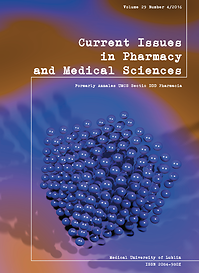Hepatic stellate cells activation and liver fibrosis after chronic administration of ethanol
DOI:
https://doi.org/10.1515/cipms-2016-0014Keywords:
hepatic stellate cells, liver, ethanol, fibrogenesis, desminAbstract
Hepatic stellate cells (HSC) are a nonparenchymal population of liver cells. In normal conditions, they store vitamin A, control the turnover of the extracellular matrix, and regulate the contractility of the sinusoids. Acute and chronic damage such as that brought about by alcohol activates the stellate cells and they are then responsible for the liver's inflammatory fibrotic response. Hence, alcohol consumption leads to hepatitis, steatosis, fibrosis and cirrhosis of liver by way of different mechanisms depending on effect upon the nonparenchymal cells of the liver.
The aim of our study was to assess the histological changes in the liver of rats after chronic alcohol consumption. In our work, we evaluated the intensity of liver fibrosis and the number of Kupffer cells and active hepatic stellate cells present within a test population. In the experiment, we used 10 Wistar rats of 250 gram weight. The animals were placed within one of two groups: A (experimental) and C (control). Group A received alcohol for 4 weeks, while group C received just water. The rats of both groups were decapitated 24 hours after the end of the experiment. The samples of liver were then evaluated after H&E, Masson’s trichrome staining and an immunohistochemical reaction to desmin (a marker of quiescent HSC) and α-smooth muscle actin (marker of active HSC) antibody. In our work, we observed intensive fibrosis in the portal spaces and perivenular areas in group A samples. Moreover, Kupffer cells and stellate cells with positive α-SMA expression were more numerous in group A than in the group C, and these correlate with the area of intensive fibrosis. The expression of desmin in the HSC was seen in both groups to a similar level. Conclusion. Chronic alcohol consumption activates the transdifferentiation of hepatic stellate cells into the positive α-SMA myofibroblast-like cells which are responsible for fibrogenesis.
References
1. Ajakaiye M et al.: Alcohol and hepatocyte-Kupffer cell interaction (review). Mol Med Rep., 4,4, 2011: 597-602, doi: 10.3892/mmr.2011.471.
2. Bąk M. et al.: Toksyczne uszkodzenie wątroby - współczesny pogląd na etiopatogenezę. Część I. (Toxic liver injuries - a current view on pathogenesis. Part I. Medycyna Pracy, 62,1, 2011:47-55.
3. Bioulac-Sage P., Balabaud Ch.: Proliferation and phenotypic expression of perisinusoidal cells. Journal of Hepatology, 15, 1992: 284-287.
4. Britton R.S., Bacon B.R.: Role of free radicals in liver diseases and hepatic fibrosis. Hepatogastroenterology, 41, 4, 1994: 343-348.
5. Burt AD, et al.: Ultrastructural localization of extracellular matrix proteins in liver biopsies using ultracryomicrotomy and immuno-gold labelling. Histopathology, 16,1, 1990:53-58.
6. Carpino G et al.: Alpha-SMA expression in hepatic stellate cells and quantitative analysis of hepatic fibrosis in cirrhosis and in recurrent chronic hepatitis after liver transplantation. Dig Liver Dis., 37, 5, 2005: 349-356.
7. Chedid A. et al.: Prognostic factors in alcoholic liver disease. VA Cooperative Study Group. Am J Gastroenterol., 86, 2,1991: 210-216.
8. Conde de la Rosa L., Moshage H., Nieto N.: Hepatocyte oxidant stress and alcoholic liver disease. Rev Esp Enferm Dig., 100, 2008:156-163.
9. De Minicis S., Brenner D.A.: Oxidative stress in alcoholic liver disease: role of NADPH oxidase complex. J Gastroenterol Hepatol., 23, 1, 2008: S98-S103.
10. Flisiak R., Wiercińska Drapało A., Tynecka E.: Transforming growth factor beta in pathogenesis of liver diseases. Wiad Lek., 53, 9-10, 2000:530-537.
11. Friedman S.L.: Hepatic stellate cells: protean, multifunctional, and enigmatic cells of the liver. Physiol Rev., 88, 1, 2008: 125-172, doi: 10.1152/physrev.00013.2007.
12. Fujii H., Kawada N.: Fibrogenesis in alcoholic liver disease. World J Gastroenterol., 7, 20, 25, 2014: 8048-8054. doi: 10.3748/wjg.v20.i25.8048.
13. Gressner A.M.: Transdifferentiation of hepatic stellate cells (Ito cells) to myofibroblasts - a key event in hepatic fibrogenesis. Kidney Int Suppl., 54, 1996: S39-S45.
14. Ionescu A.G. et al.: Histopathological and immunohistochemical study of hepatic stellate cells in patients with viral C chronic liver disease. Rom J Morphol Embryol., 54,4, 2013:983-991.
15. Kasztelan-Szczerbińska B. et al.: Komórki gwiaździste jako główny regulator sygnalizacji międzykomórkowej w procesie włóknienia wątroby. (Stellate cells as a central regulator of intracellular signaling in the process of liver fibrosis). Postępy Nauk Medycznych,1, 2010:69-74.
16. Kisseleva T. et al.: Myofibroblasts revert to an inactive phenotype during regression of liver fibrosis. Proc Natl Acad Sci U S A, 12,109, 24, 2012: 9448-9453, doi: 10.1073/pnas.1201840109.
17. Kmieć Z.: Cooperation of liver cells in health and disease. Adv Anat Embryol Cell Biol.,161, III-XIII, 2001: 1-151.
18. Mormone E., George J., Nieto N.: Molecular pathogenesis of hepatic fibrosis and current therapeutic approaches. Chem Biol Interact., 30, 193, 3, 2011:225-231, doi: 10.1016/j.cbi.2011.07.001.
19. Page A. et al.: Alcohol directly stimulates epigenetic modifications in hepatic stellate cells. J Hepatol., 62, 2, 2015: 388-397, doi: 10.1016/j.jhep.2014.09.033.
20. Plewka K., Szuster-Ciesielska A., Kandefer-Szerszeń M.: Rola komórek gwiaździstych w procesie alkoholowego włóknienia wątroby (Role of stellate cells in alcoholic liver fibrosis) Postepy Hig Med Dosw., 63, 2009: 303-317.
21. Suh Y.G., Jeong W.I.: Hepatic stellate cells and innate immunity in alcoholic liver disease. World J Gastroenterol, 28,17,20, 2011: 2543-2451, doi: 10.3748/wjg.v17.i20.2543.
22. Szantova M., Kupcova V.: Biochemical markers of fibrogenesis in liver diseases. Bratisl Lek Listy, 100,1, 1999: 28-35.
23. Tomanovic N.R. et al.: Activated liver stellate cells in chronic viral C hepatitis: histopathological and immunohistochemical study. J Gastrointestin Liver Dis., 18, 2, 2009: 163-167.
24. Tsukamoto H. et al.: Roles of oxidative stress in activation of Kupffer and Ito cells in liver fibrogenesis. J Gastroenterol Hepatol., 10, 1, 1995:S50-S53.
25. Tsukamoto H.: Oxidative stress, antioxidants and alcoholic liver fibrogenesis. Alcohol., 10,6, 1993:465-467.
26. Wan J. et al.: M2 kupffer cells promote hepatocyte senescence: an IL-6-dependent protective mechanism against alcoholic liver disease. Am J Pathol. 184,6, 2014:1763-1772, doi: 10.1016/j.ajpath.2014.02.014.
Downloads
Published
Issue
Section
License
Copyright (c) 2016 Authors

This work is licensed under a Creative Commons Attribution-NonCommercial-NoDerivatives 3.0 Unported License.


